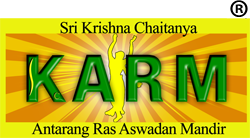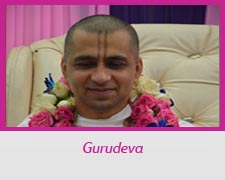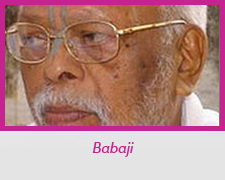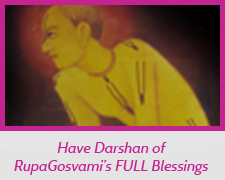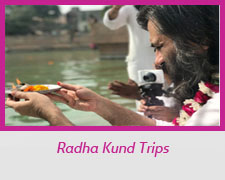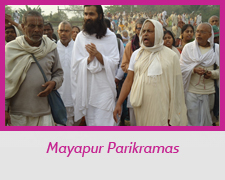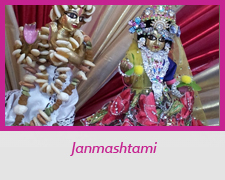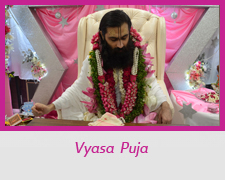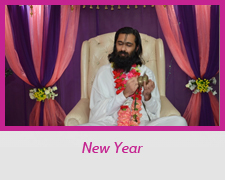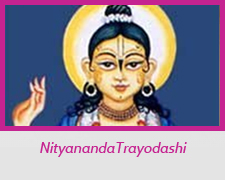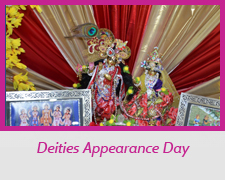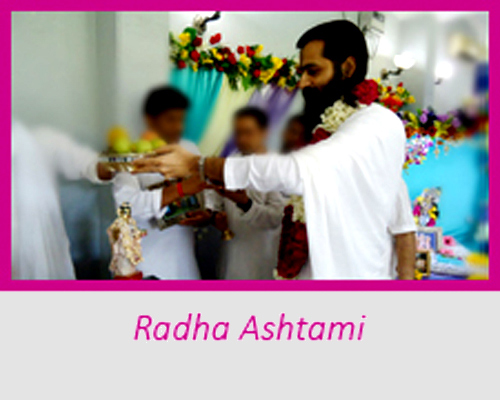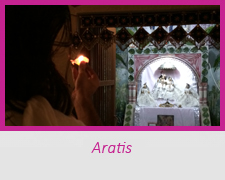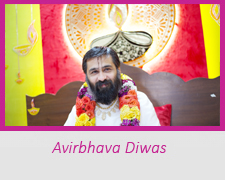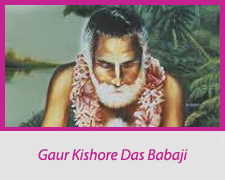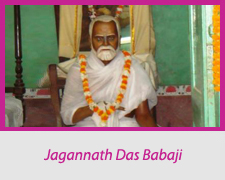Tilaka…
Tilaka varies in design and composition according to the group an affiliate belongs to, and so the various Vaiñëava Sampradäyas each have their own distinctive Tilaka which depict the siddhanta of their particular lineage.
However for a Gauòéya Vaiñëava, the significance of tilaka comes from the eternal svarüpa he has in Navadvépa Dhäma. Gauòéya Vaiñëava sampradäyas are coming from Mahäprabhu’s Lineage and have two svarüpas- as a maïjaré in Nitya Våndävana and simultaneously as Kiçora Brähmaëa in Nitya Navadvépa. A Kiçora Brähmaëa eternally wears the same tilaka, which one gets from His Spiritual Master in sädhaka stage at the time of initiation. According to bonafide sampradäya, a devotee belongs to lineage of Çréman Gauräìga Mahäprabhu’s Associate i.e. all bonafide Gauòéya Vaiñëava Parivära, devotees have different tilakas, and all the members of the same Parivära wear same, one kind of Tilaka.
Devotees should have transcendental pride wearing “this” tilaka given by their respective Guru, for it is actually our true identity. The tilaka determines who we actually are and where do we belong to. Caste, creed, colour, material names of this material world are all temporary and will end with the end of the body, but the eternal identity stays for eternity.
One must understand that the tilaka one puts on body here, is the eternal tilaka in Navadvépa. This tilaka is not just for this world, it is eternal and has been passed down through a lineage of disciplic succession starting from eternal associates of Lord Gauräìga. One should put on that tilaka throughout his life which one’s Gurudeva gives at the time of Dékñä.
Attainment of Eternal Tilaka in conditioned state!
Receiving Initiation (with Mantras, Tilaka etc.) in a Bonafide Gauòéya Vaiñëava Paramparä is a matter of the highest fortune for any jéva, for, one not only gets the opportunity to be connected to the Lord, but also gets the eternal identification (tilaka) in the conditioned state itself. Even Lord Gauräìga Mahäprabhu Himself wears a tilaka daily.
candana-lepita-aìga, tilaka suöhämamatta-gaja jini’ mada-manthara paynä
(Cc Ädi 5.187)
Mahäprabhu’s body was anointed with sandalwood pulp, and He was nicely decorated with tilaka. His movements surpassed those of a maddened elephant.
Different Tilakas for different Pariväras-
As mentioned above, the tilaka is a cinha, a symbol which determines our Parivära. Different Pariväras have different unique shaped tilaka, each easily distinguishable from the other. For example, Nityänanda Prabhu puts a different tilaka, Advaita Prabhu’s Parivära puts different Tilaka. Similarly, Pariväras of Gadädhara Paëòita, Çréväsa Paëòita, Vakreçvara Paëòita and Çyämänanda Prabhu all have got different Tilakas from each other.
Nityänanda Parivära has a sharp triangular leaf in their tilaka.
Advaita Parivära has a heart shaped large banyan leaf.
Narottama Parivära has a tulasé leaf with a small stem.
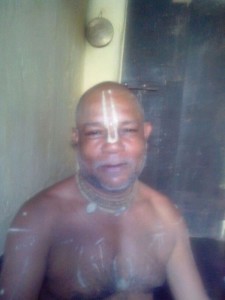
Çyämänanda Parivära Tilaka
Çyämänanda Parivära has an imprint of Rädhä’s ankle bell with a dot in the centre.
Srinivasa Acarya Parivara has a symbol of tamal tree leaf.
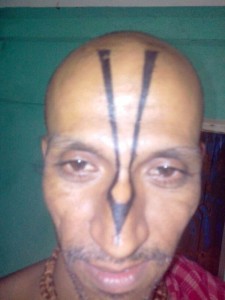
Gadadhara Parivära Tilaka
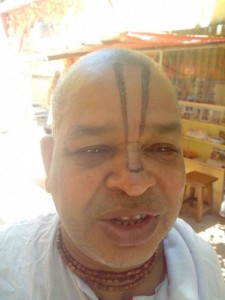
Vakreçvara Parivära Tilaka
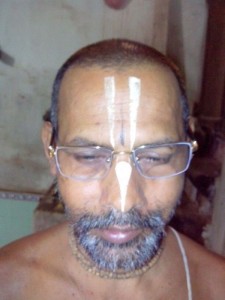
Gopäla Bhatta Gosvämi Parivära
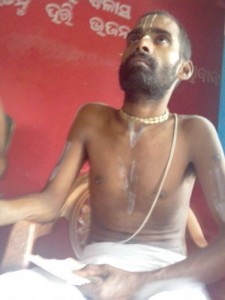
Jéva Gosvämé Parivära
Devotees belonging to the same Parivära apply/wear the same kind of tilaka. All the bonafide Gurus of the same Parivära apply the same tilaka.
Among Gauòéya Vaiñëavas, there are different eternal pariväras. It is in appropriate to put two (or more) äcäryas of different pariväras together.
Question- why it is inappropriate?
Answer- because they are eternally two different eternal pariväras.
Vidhi to apply Tilaka-
Without decorating/applying tilaka on the body, all sädhanä is futile. There is a proper vidhi, a procedure/method in which one applies tilaka on one’s body. After taking bath and before resuming his daily sädhanä, Gauòéya Vaiñëava puts on 12 tilakas, as mentioned in Caitanya Caritamåta..
dvädaça-tilaka-mantra ei dvädaça nämaäcamane ei näme sparçi tat-tat-sthäna
(Madhya 20.202)
The twelve places of the body where tilakas are to be applied and the mantra chanted are-
lalāṭe keśavaṁ dhyāyen nārāyaṇam athodare
vakṣaḥ-sthale mādhavaṁ tu govindaṁ kaṇṭha-kūpake
viṣṇuṁ ca dakṣiṇe kukṣau bāhau ca madhusūdanam
trivikramaṁ kandhare tu vāmanaṁ vāma-pārśvake
śrīdharaṁ vāma-bāhau tu hṛṣīkeśaṁ tu kandhare
pṛṣṭhe ca padmanābhaṁ ca kaṭyāṁ dāmodaraṁ nyaset
| Place of the body | Mantra |
|---|---|
| Place of the body | Mantra |
| Forehead | Çré Keçavaya namaù |
| Lower Abdomen | Çré Näräyaëaya namaù |
| Chest | Çré Mädhavaya namaù |
| Hollow of the neck | Çré Govindaya namaù |
| Right side of the belly | Çré Viñëaya namaù |
| Right arm | Çré Madhusüdanaya namaù |
| Right shoulder | Çré Trivikramaya namaù |
| Left side of the belly | Çré Vämanäya namaù |
| Left arm | Çré Çrédharäya namaù |
| Left shoulder | Çré Håkeçäya namaù |
| Upper back | Çré Padmanäbhaya namaù |
| Lower back | Çré Dämodaräya namaù |
The remaining tilaka from palm should be smeared/rubbed over scalp while reciting Çré Väsudeväya namaù.
Deviations from reality-
In the past over 100 years, many deviations from Real Gauòéya Vaiñëavism in context to Philosophy, Tradition, Tilaka etc. have taken place. One must always follow Guru, Sädhu, Çästra in every sphere for success, especially for knowing the basic understanding about Gauòéya Vaiñëavism.
Gauòéya Vaiñëavas coming in proper paramparäs, the followers of Gosvämés never apply yellowish tilaka. One can go and see/check this in Våndävan, Rädhäkuëòa, Barsänä, Navadvépa, Jagannätha Püré by just spending few days there. In the nitya svarüpa of Kiçora Brahmaëa, the shiny and glorious ‘raja’ of Dhäma is worn as Tilaka, which has got blackish hue. From the time of Mahäprabhu till now, tilaka of Gauòéya Vaiñëavas is from Vraja-raja- blackish in colour. All proper lineages, from Advaita, Narottama etc never put yellowish tilaka in past, do not put yellowish tilaka in present and in future also the genuine followers of Çré Rüpa Sanätana will follow their worshipable Guru-Varga only.
Every Parivära has its own well-defined Tilaka, which is applied in one particular manner from the time immemorial. Tilaka cannot be manufactured nor can any institution claim to have invented one or have exclusive rights over any bona-fide tilaka.
Scriptures’ speak/opinion on Tilaka-
There are several references in various scriptures extolling the eternality and the importance of applying tilaka daily.
yajno dänaà tapo homaù svädhäyaù pitåutarpaëaà
vyarhtam bhavati tatsarvaà ürdhvapunòram vinäkåtaà
Sacrifice (Yajna), Charity (däna), Austerity (tapas), homa, Study of Scriptures (Vedädhyayana) and Sacrifices to forefathers (pitåutarpaëa) done without applying tilaka (ürdhvapunòras) is absolutely useless
urdhpund dharo mrtyo mriyate yatra kutrachit
çavapak api vimanastho mäm loke mahiyate
No matter where a person dies who has applied tilaka on his body or in whichever way he dies, even if he is dog eating witch, even then he goes to the abode of Lord on the spiritual planet and is worshipped there.
In the Padma Puräëa it is mentioned that persons who apply tilaka, are to be understood as the devotees of Lord in this world. Their presence makes the world purified, and anywhere they remain, they make that place as good as the Spiritual World.”
A similar statement is in the Skanda Puräëa, which says, “Persons who are decorated with tilaka and who mark their bodies all over with the holy names of the Lord, and on whose necks and breasts there are tulasé beads, are never approached by the Yamadūtas.”
The Padma Puräëa also mentions, “A person whose body is decorated with the tilaka, with paintings of the holy name of the Lord, is delivered from all sinful reactions, and after his death he goes directly to Kṛṣṇaloka/Eternal Abode to live in association with the Supreme Lord.”
On the other hand if one fails to apply tilaka given/ bestowed to him by his Guru or he feels ashamed in doing so, thinking he might get ridiculed, then he commits offence at the lotus feet of his Çré Guru and there is no one who is more unfortunate than him.
